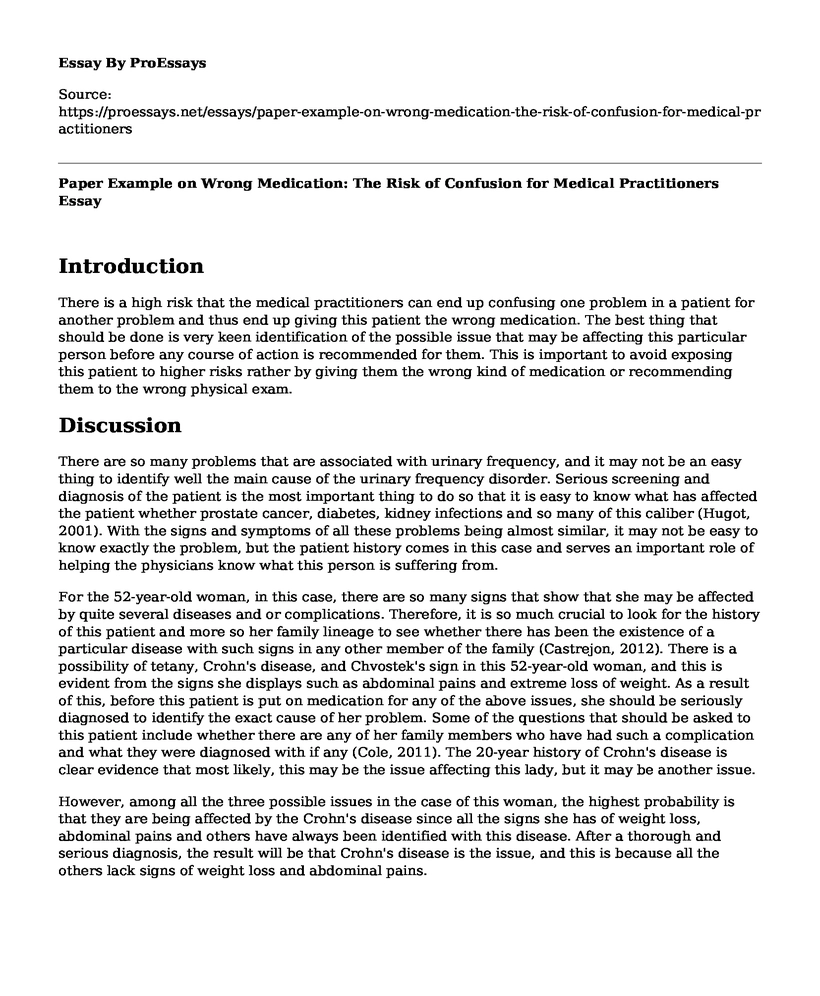Introduction
There is a high risk that the medical practitioners can end up confusing one problem in a patient for another problem and thus end up giving this patient the wrong medication. The best thing that should be done is very keen identification of the possible issue that may be affecting this particular person before any course of action is recommended for them. This is important to avoid exposing this patient to higher risks rather by giving them the wrong kind of medication or recommending them to the wrong physical exam.
Discussion
There are so many problems that are associated with urinary frequency, and it may not be an easy thing to identify well the main cause of the urinary frequency disorder. Serious screening and diagnosis of the patient is the most important thing to do so that it is easy to know what has affected the patient whether prostate cancer, diabetes, kidney infections and so many of this caliber (Hugot, 2001). With the signs and symptoms of all these problems being almost similar, it may not be easy to know exactly the problem, but the patient history comes in this case and serves an important role of helping the physicians know what this person is suffering from.
For the 52-year-old woman, in this case, there are so many signs that show that she may be affected by quite several diseases and or complications. Therefore, it is so much crucial to look for the history of this patient and more so her family lineage to see whether there has been the existence of a particular disease with such signs in any other member of the family (Castrejon, 2012). There is a possibility of tetany, Crohn's disease, and Chvostek's sign in this 52-year-old woman, and this is evident from the signs she displays such as abdominal pains and extreme loss of weight. As a result of this, before this patient is put on medication for any of the above issues, she should be seriously diagnosed to identify the exact cause of her problem. Some of the questions that should be asked to this patient include whether there are any of her family members who have had such a complication and what they were diagnosed with if any (Cole, 2011). The 20-year history of Crohn's disease is clear evidence that most likely, this may be the issue affecting this lady, but it may be another issue.
However, among all the three possible issues in the case of this woman, the highest probability is that they are being affected by the Crohn's disease since all the signs she has of weight loss, abdominal pains and others have always been identified with this disease. After a thorough and serious diagnosis, the result will be that Crohn's disease is the issue, and this is because all the others lack signs of weight loss and abdominal pains.
Conclusion
In conclusion, therefore, if the patient is to be treated, she should be treated with Crohn's disease. However, this should only come after she has undergone serious physical exams to prove the existence of all signs of this disease. By the physician being sure, they will avoid exposing the woman to more risks and treating them for what they are not suffering from (Ogura, 2001). In this case, the patient's 20-year history of Crohn's problem in the family lineage will have played a vital role in diagnosing and treating this patient.
References
Castrejon, I., McCollum, L., Tanriover, M. D., & Pincus, T. (2012). Importance of patient history and physical examination in rheumatoid arthritis compared to other chronic diseases: results of a physician survey. Arthritis care & research, 64(8), 1250-1255.
Cole, M., & Morgan, K. (2011). Vegaphobia: derogatory discourses of veganism and the reproduction of speciesism in UK national newspapers 1. The British Journal of Sociology, 62(1), 134-153.
Hugot, J. P., Chamaillard, M., Zouali, H., Lesage, S., Cezard, J. P., Belaiche, J., ... & Binder, V. (2001). Association of NOD2 leucine-rich repeat variants with susceptibility to Crohn's disease. Nature, 411(6837), 599.
Ogura, Y., Bonen, D. K., Inohara, N., Nicolae, D. L., Chen, F. F., Ramos, R., ... & Achkar, J. P. (2001). A frameshift mutation in NOD2 associated with susceptibility to Crohn's disease. Nature, 411(6837), 603.
Cite this page
Paper Example on Wrong Medication: The Risk of Confusion for Medical Practitioners. (2023, Jan 26). Retrieved from https://proessays.net/essays/paper-example-on-wrong-medication-the-risk-of-confusion-for-medical-practitioners
If you are the original author of this essay and no longer wish to have it published on the ProEssays website, please click below to request its removal:
- Article Review Example: Analysis of Social Welfare Issue
- Zika Virus Research Paper
- Acquisition of Healthy Habits Paper Example
- Paper Example on Drug Testing: Medical Marijuana & HR Debate
- Essay Sample on Craniotomy: Removing & Replacing Skull Bone for Brain Surgery
- Strategies for Optimizing Hospital Performance & Safety - Essay Sample
- Nursing - Case Study Sample







